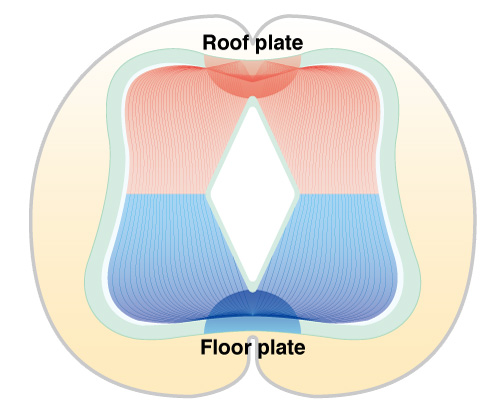
News & Events
News & Events
News
August 07, 2018
Making the spinal cord from iPS cells

CiRA researchers show iPS cells can make the roof plate and floor plate, two key structures that lead to the dorsal-ventral anatomy of the spinal cord.
CiRA researchers show iPS cells can make the roof plate and floor plate, two key structures that lead to the dorsal-ventral anatomy of the spinal cord.
Organoids are three dimensional organs made in the lab using pluripotent stem cells. Rather than using stem cells to make individual cell types and then assembling them together to make the organ, organoids form all the cells simultaneously in a way that mimics the natural development of the organ both in terms of time and space. Recreating this development is believed to better recapitulate diseases of the organ, because it considers how different cell types interact during development. Applying organoid technology to the brain, CiRA Professor and neurosurgeon Jun Takahashi and his research team report in the journal Development in the world spinal cord organoid made from human iPS cells.
The spinal cord consists of cells with two distinctive functions. Somatosensory cells are those that inform the brain of sensations like touch, while primary motor neurons and motor-related interneurons are how the brain informs the body to move in response to those sensations.
"Somatosensory neurons are mostly derived from dorsal side of the spinal cord. On the other hand, primary motor neurons and motor-related interneurons are from the ventral side," says neurologist and lead author of the study, Dr. Hideya Sakaguchi. This spatial organization has a crucial role in spinal cord function, but has not been recreated in the laboratory.
A major reason, explains Sakaguchi, is that scientists have been unable to generate the spinal cord's organizing centers, from which the cells organically assemble in their proper order.
"The roof plate is responsible for organizing the dorsal spinal cord and the floor plate is responsible for organizing the ventral spinal cord," he said.
In the field of neuroscience, there exists a standard protocol to prepare spinal cord motor neurons from iPS cells. Sakaguchi and his colleagues realized that refining the protocol by adding and removing specific chemicals could induce the most comprehensive to date spinal cord made from iPS cells.
"The roof plate induces dorsal progenitor domains by producing bone morphogenetic proteins (BMPs), and the floor plate induces ventral progenitor domains by producing Sonic Hedgehod (Shh)," Sakaguchi continued.
Dorsal progenitor cells give rise to all the different somatosensory neuron subtypes, while ventral progenitor cells will go on to give rise to all the primary motor neurons and interneurons subtypes of the spinal cord.
Formation of these plates in the organoids led to progenitor domains spatially organizing as they do when the spinal cord forms in the embryo.
"The domains were positioned from the roof plate and the floor plate as they do in the spinal cord," said Sakaguchi about his organoid.
Takahashi believes the ability to recreate not only spinal cord cells, but the spatial organization of these cells from human iPS cells will provide a new way to study development diseases of this fundamental structure.
"Many diseases are the result not of defective cells, but defective cell interactions. Organoids are well suited for studying these interactions and finding drugs that can cure them," he said.
Paper Details
- Journal: Development
- Title: Three-dimensional induction of dorsal, intermediate, and ventral spinal cord tissues form human pluripotent stem cells
- Authors: Takenori Ogura1,2, Hideya Sakaguchi1, Susumu Miyamoto2, and Jun Takahashi1,2
- Author Affiliations:
- Center for iPS Cell Research and Application (CiRA), Kyoto University, Kyoto, Japan
- Department of Neurosurgery, Kyoto University Graduate School of Medicine, Kyoto University, Kyoto, Japan






















